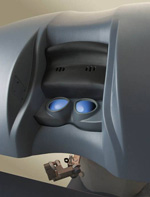Robotic Surgery using the 'da Vinci' Surgical System

Da Vinci robotic surgery is the most advanced surgical technology available today. It represents the culmination of decades of scientific and surgical innovation.
Robotic surgery is the ultimate form of laparoscopic minimally invasive surgery. Using the Robot, surgeons are able to perform most surgical procedures through small incisions on the abdomen instead of using a traditional laparotomy (large abdominal incision).
Dr. Hunter is a trained daVinci surgeon. Dr. Hunter has performed more than 300 Robotic surgeries in Harlingen. She is also a proctor for daVinci trainees.
Firsts
Dr. Hunter has many Cameron County or South Texas "firsts", including:
- first to perform single incision hysterectomy
- first to perform tubal reconstruction leading to a successful pregnancy
- first to complete more than 100 (now 700+ in 2019) robotic surgeries
For more information regarding the da Vinci surgical system please visit the Intuitive Surgical website: www.davincisurgery.com
Frequently Asked Questions
How is 'da Vinci' Surgery different?

Conventional gynecologic and general surgery is performed through a 6-12 inch incision on the abdominal wall. This large incision allows for excellent visualization of the operative field and permits surgeons to operate on the pelvic and abdominal organs with direct contact. The disadvantage of conventional surgery is that the patient is left with a large abdominal scar, has a long hospital stay, and prolonged recovery.
Laparoscopic surgery is performed through small keyhole incisions on the abdomen. A small telescopic camera (laparoscope) is placed through the belly button (umbilicus) and allows for indirect two-dimensional visualization of the entire abdomen and pelvis. Surgery is performed with long narrow instruments that are placed through other small keyhole incisions on the abdominal wall. The end of the instrument can open, close and rotate, but does not provide any additional range of motion. Because of these limitations, laparoscopic surgical proficiency in complicated procedures is very difficult to achieve.

Da Vinci Surgery is an advanced type of Laparoscopic surgery. The da Vinci laparoscope contains two separate cameras. The two images are superimposed at the surgeon's operative terminal, which creates a binocular image, and provides true 3-D visualization of the operative field. The robotic arm holds the laparoscope which allows the surgeon direct control of the surgical image (instead of having to rely on the surgical assistant). The surgical instruments are controlled by the surgeon, and have the same free range of motion as the surgeon's wrist. This allows for surgeons to perform surgery laparoscopically with greater ease and precision than if their hands were actually inside the abdomen.
These technological advances offer all of the following advantages over conventional laparoscopic surgery:
- Better visualization
- Better instrumentation allowing for more precise surgical dissection
- Better surgical dexterity simplifying complex surgical procedures
- Easier and faster suturing
- Surgeon's control of the robotic arms allows for less dependence on the surgical assistant
- Allows specialists to perform difficult cases laparoscopically
- Better ergonomics allows for decreased surgeon fatigue
What types of surgical procedures can be done with the da Vinci Robot?
- Hysterectomy
- Removal of Fibroid tumors (Myomectomy)
- Removal of Ovarian cysts, ovarian tumors
- Infertility surgery (tubal reanastamosis and correction of abnormal tube)
- Endometriosis surgery
- Prolapse surgery (suspension of fallen vaginal apex (e.g. Sacral-colpopexy))
- Surgery to clear scar tissue from infection, previous surgeries or endometriosis
What questions should I ask my doctor about Robotic Surgery?
Keep in mind that conventional laparotomy, laparoscopy, and da Vinci surgery all fall within the standard of care, and each have their own advantages and disadvantages. Your physician should be able to explain these details to your satisfaction. Every surgery, and every patient, is different and you should discuss each of these surgical options with your physician.
When you have a condition which requires surgery, it can be a very difficult and frightening time in your life. You must feel completely contented with, and confident in your physician. If you are comfortable with your doctor, then any of the above options should be satisfactory. However if your physician is uncomfortable with or irritated by discussing these options you should seek a second opinion.
You should ask your physician the following questions:
- What type of surgery do you think is best for me and why?
- How many laparoscopic or Robotic procedures have you done?
- If we schedule Robotic Surgery, what are the chances that I will end up having an open incision to complete the surgery. Or: What is your Conversion Rate? (for example: Dr. Hunter's Conversion Rate is less than 2%.)
Is the robotic surgery covered by my insurance?
Yes. Most likely, if your insurance carrier approves the surgery, it can be performed by laparotomy, laparoscopy, or da Vinci. Some insurers are currently limiting access to da Vinci surgery and also limiting surgeon and hospital choices. If surgery is indicated, we will contact your insurance company to verify benefits and policy coverage.
